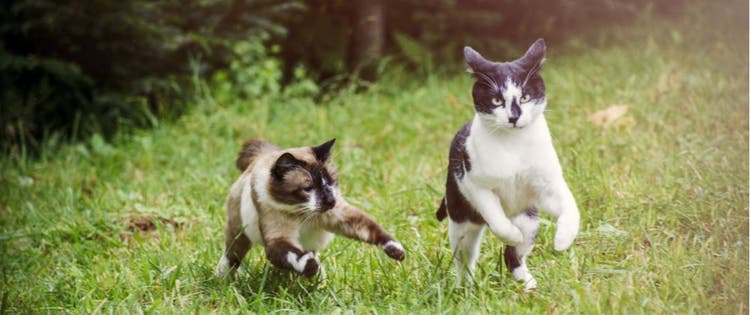
How Cats Play
Cats, like all mammals, engage in play as youngsters and continue to do so even after they have grown up. Play is a complex learning activity that helps kittens develop social relationships and helps them hone their physical and mental skills. But it is also fun, which is why adult cat continue to do it. You can spend many enjoyable hours just watching with amusement as your cat plays. Watching a cat play is one of the most entertaining pastimes afforded to the cat owner. A cat’s play takes three forms, though often it is sometimes difficult to separate them.
Social Play
Social play is how kittens learn to interact with their littermates, their mother, other cats, other household pets, and you. During social play, kittens test their world and learn their place in it. Kittens develop personality traits based on their playful interactions that accompany them into adulthood. As a kitten grows, social play with littermates gives way to social play with their human caregiver(s), assuming that the kitten is adopted into a family and is not simply fending for herself.
Object Play
Poking, batting, and tossing around small objects are ways that kittens learn about how to deal with prey. During such play sessions they develop the survival skills that they might need if they ever have to provide for themselves. You may see your kitten stomp on her toys, flip them over, and circle them once they land – acts that mimic overpowering and killing a prey animal for food. Object play teaches a cat how the world and things in it feel, what is animate and what is inanimate. She may jump up from her toys as if noxious, invisible rays emanate from them, and then dissolve into fits of sheer delight and discovery.
Locomotor Play
An active cat is a confident cat. The running and jumping of locomotor play helps a kitten increase strength, coordination, and flexibility. Locomotor play also stimulates a cat’s appetite while helping to keep her physically fit. In addition, locomotor play helps eliminate boredom. An active play session at night can help reduce a cat’s nocturnal perambulations, which otherwise may keep the cat’s owner awake.
In addition to the physical lessons play teaches kittens and cats, play also teaches emotional ones. Kittens learn that playing is just plain fun and that it feels good to run, jump and cavort with other cats and animals, including human ones.
A Lifetime of Play
During a kitten’s first 4 weeks of life, she will be too busy nursing, sleeping, and learning to see and hear to want to or be able to play. During that time, a crinkly or jingling ball will have no effect on her. She will not be able to focus her vision on a moving object and will not have the strength and coordination to chase a wiggling wand toy. She will be too small, too uncoordinated, and too fragile to engage in any games.
After 4 weeks of age, it’s safe for you to engage in play with your kitten. From 7 to 8 weeks, kittens are most active but they will continue to play actively until they are 12 to 14 weeks old. Play comes naturally to young kittens, but an adult that prefers to eat and sleep may need some encouragement from you. Playing with your cat increases the bond you share and is a good way to learn about her. Play also provides an outlet for her energy and wards off potential behavior problems caused by too much time and too few interests. Interactive play diverts your cat’s attention to a toy and helps keep her from attacking your ankles for attention.
Toys for Cats
Playing with your kitten will help her establish a closer relationship with you, but make sure you provide her with safe toys. Know what objects are safe as toys. Consult your veterinarian if you have any doubt. Like toys for a human toddler, pet toys shouldn’t be too heavy for your pet to handle but they should be large enough so they can’t be swallowed. Also, make sure they’re not made of a toxic substance. Cats may consume small toy parts as well, so be cautious of very small attachments, strings, buttons and bells. Cats are individuals with different energy levels. A toy that appeals to one may not appeal to another. Many cats enjoy chasing a small fabric swatch attached to the end of a fishing pole toy that mimics a moth in flight. Pole toys with larger stuffed animals at the end are difficult to chase and may even frighten some cats. Roll a ping-pong ball in the bathtub to see if a game of bat-the-ball interests your cat. You may find your cat bringing a crumpled piece of paper back to you in her own version of “fetch.” If you have more than one cat, play with all of them to prevent squabbles.
You may find her chasing imaginary playmates in her own world of make-believe. Try giving her a paper sack or a box with holes cut into it so that she can invent games for herself. But interactive play is best. How the two of you play together is only limited by your imagination.
Imagination is Key
A pet’s imagination is boundless. All animal play is spontaneous and whimsical. Animal games are without many rules and mainly just for pleasure, although much of animal play is meaningful, allowing the cat to rehearse and learn life’s lessons. Play has been noted in animals in the wild as well as in pets, and enjoyment seems to be the common theme.
Use your imagination as well. For example, cats respond primarily to movement. Therefore, any lightweight, small object may be a toy to chase and pounce on. Make up a game for your pet, follow her natural antics and build on the “variations on a theme” concept.